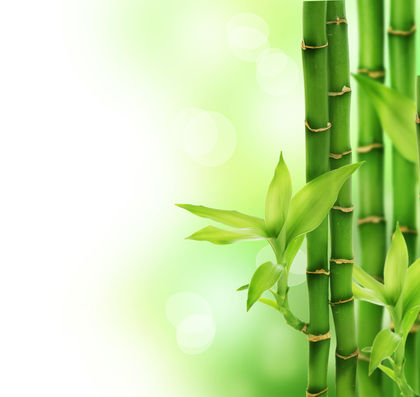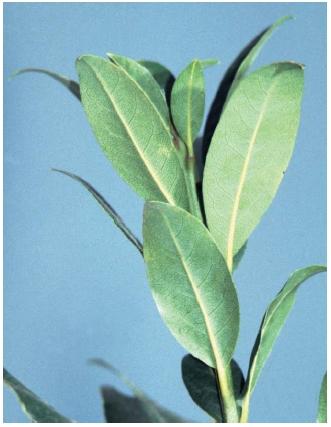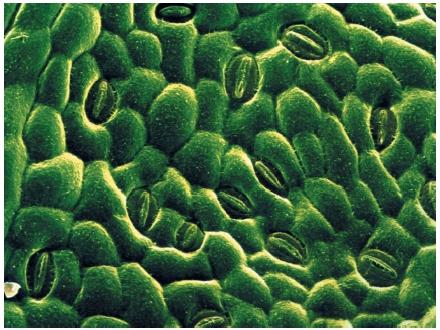Leaf

A leaf is a plant's principal organ of photosynthesis, the process by which sunlight is used to form foods from carbon dioxide and water. Leaves also help in the process of transpiration, or the loss of water vapor from a plant.
A typical leaf is an outgrowth of a stem and has two main parts: the blade (flattened portion) and the petiole (pronounced PET-ee-ole; the stalk connecting the blade to the stem). Some leaves also have stipules, small

paired outgrowths at the base of the petiole. Scientists are not quite sure of the function of stipules.
Leaf size and shape differ widely among different species of plants. Duckweeds are tiny aquatic plants with leaves that are less than 0.04 inch (1 millimeter) in diameter, the smallest of any plant species. Certain species of palm trees have the largest known leaves, more than 230 feet (70 meters) in length.
Words to Know
Abscission layer: Barrier of special cells created at the base of petioles in autumn.
Blade: Flattened part of a leaf.
Chloroplasts: Small structures that contain chlorophyll and in which the process of photosynthesis takes place.
Margin: Outer edge of a blade.
Midrib: Single main vein running down the center of a blade.
Petiole: Stalk connecting the blade of a leaf to the stem.
Phloem: Plant tissue consisting of elongated cells that transport carbohydrates and other nutrients.
Photosynthesis: Process by which a plant uses sunlight to form foods from carbon dioxide and water.
Stomata: Pores in the epidermis of leaves.
Transpiration: Evaporation of water in the form of water vapor from the stomata.
Xylem: Plant tissue consisting of elongated cells that transport water and mineral nutrients.
Leaf arrangement
A leaf can be classified as simple or compound according to its arrangement. A simple leaf has a single blade. A compound leaf consists of two or more separate blades, each of which is termed a leaflet. Each leaflet can be borne at one point or at intervals on each side of a stalk. Compound leaves with leaflets originating from the same point on the petiole (like fingers of an outstretched hand) are called palmately compound. Compound leaves with leaflets originating from different points along a central stalk are called pinnately compound.
All leaves, no matter their shape, are attached to the stem in one of three ways: opposite, alternate, or whorled. Opposite leaves are those growing in pairs opposite or across from each other on the stem. Alternate leaves are attached on alternate sides of the stem. Whorled leaves are three or more leaves growing around the stem at the same spot. Most plant species have alternate leaves.
Blade
The outer edge of a blade is called the margin. An entire margin is one that is smooth and has no indentations. A toothed margin has small or wavy indentations. A lobed margin has large indentations (called sinuses) and large projections (called lobes).

Venation is the pattern of veins in the blade of a leaf. A single main vein running down the center of a blade is called a midrib. Several main veins are referred to as principle veins. A network of smaller veins branch off from a midrib or a principle vein.
All veins transport nutrients and water in and out of the leaves. The two primary tissues in leaf veins are xylem (pronounced ZY-lem) and phloem (pronounced FLOW-em). Xylem cells mainly transport water and mineral nutrients from the roots to the leaves. Phloem cells mainly transport carbohydrates (made by photosynthesis) from the leaves to the rest of the plant. Typically, xylem cells are on the upper side of the leaf vein and phloem cells are on the lower side.
Internal anatomy of leaves
Although the leaves of different plants vary in their overall shape, most leaves are rather similar in their internal anatomy. Leaves generally consist of epidermal tissue on the upper and lower surfaces and mesophyll tissue throughout the body.
Epidermal cells have two features that prevent the plant from losing water: they are packed densely together and they are covered by a cuticle (a waxy layer secreted by the cells). The epidermis usually consists of a single layer of cells, although the specialized leaves of some desert plants have epidermal layers that are several cells thick. The epidermis contains small pores called stomata, which are mostly found on the lower leaf surface. Each individual stoma (pore) is surrounded by a pair of specialized guard cells. In most species, the guard cells close their stomata during the night (and during times of drought) to prevent water loss. During the day, the guard cells open their stomata so they can take in carbon dioxide for photosynthesis and give off oxygen as a waste product.
The mesophyll layer is divided into two parts: palisade cells and spongy cells. Palisade cells are densely packed, elongated cells lying directly beneath the upper epidermis. These cells house chloroplasts, small structures that contain chlorophyll and in which the process of photosynthesis takes place. Spongy cells are large, often odd-shaped cells lying underneath palisade cells. They are loosely packed to allow gases (carbon dioxide, oxygen, and water vapor) to move freely between them.
Leaves in autumn
Leaves are green in summer because they contain the pigment chlorophyll, which absorbs all the wavelengths of sunlight except for green (sunlight or white light comprises all the colors of the visible spectrum: red, orange, yellow, green, blue, indigo, and violet). In addition to chlorophyll, leaves contain carotenoid (pronounced kuh-ROT-in-oid) pigments, which appear orange-yellow. In autumn, plants create a barrier of special cells, called the abscission (pronounced ab-SI-zhen) layer, at the base of the petiole. Moisture and nutrients from the plant are cut off and the leaf begins to die. Chlorophyll is very unstable and begins to break down quickly. The carotenoid pigments, which are more stable, remain in the leaf after the chlorophyll has faded, giving the plant a vibrant yellow or gold appearance.
The red autumn color of certain plants comes from a purple-red pigment known as anthocyanin (pronounced an-tho-SIGH-a-nin). Unlike carotenoids, anthocyanins are not present in a leaf during the summer. They are produced only after a leaf starts to die. During the autumn cycle of warm days and cool nights, sugars remaining in the leaf undergo a chemical reaction, producing anthocyanins.
[ See also Photosynthesis ]
thanks and god bless........
about my assignments!!!
thanks